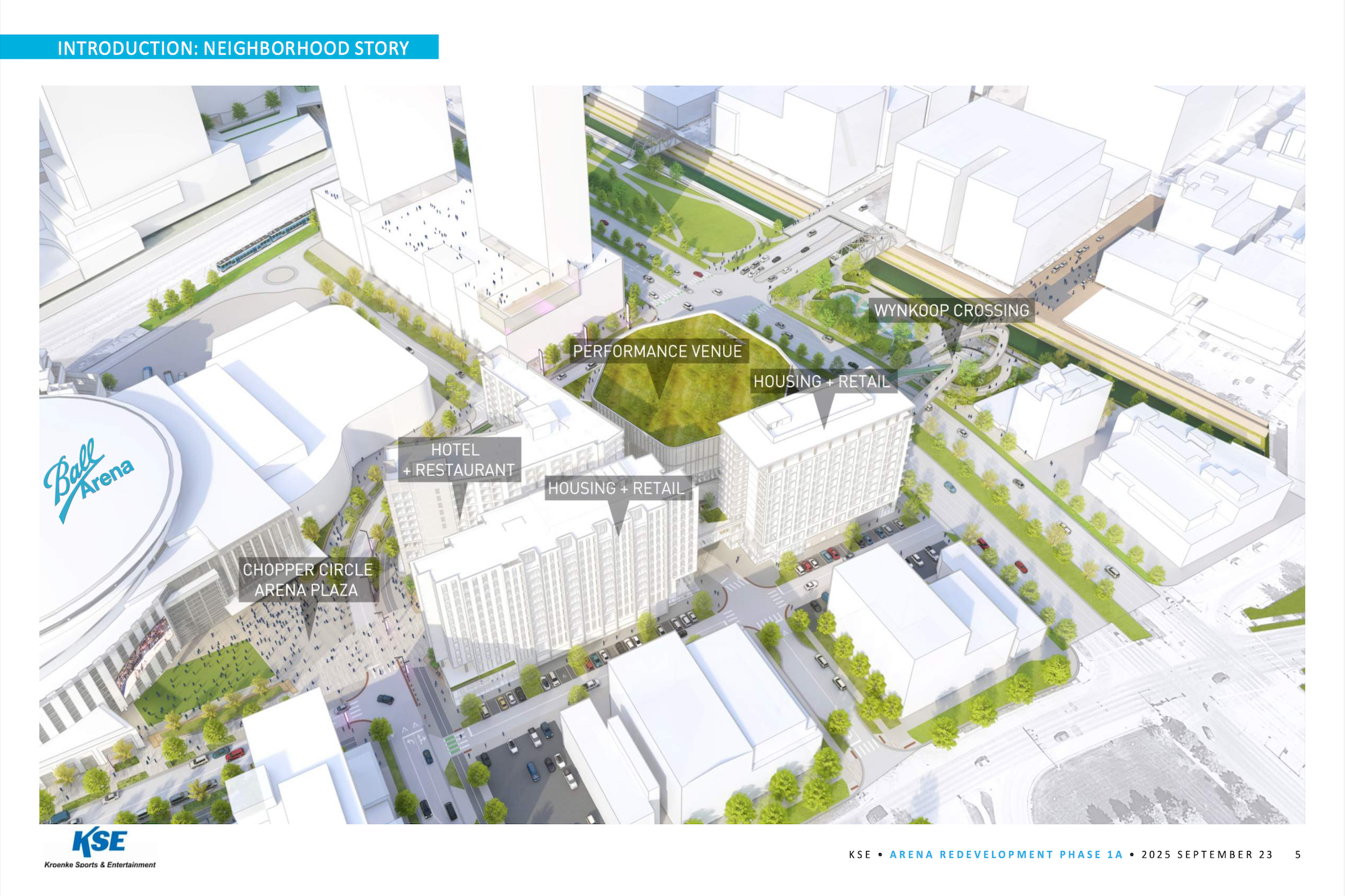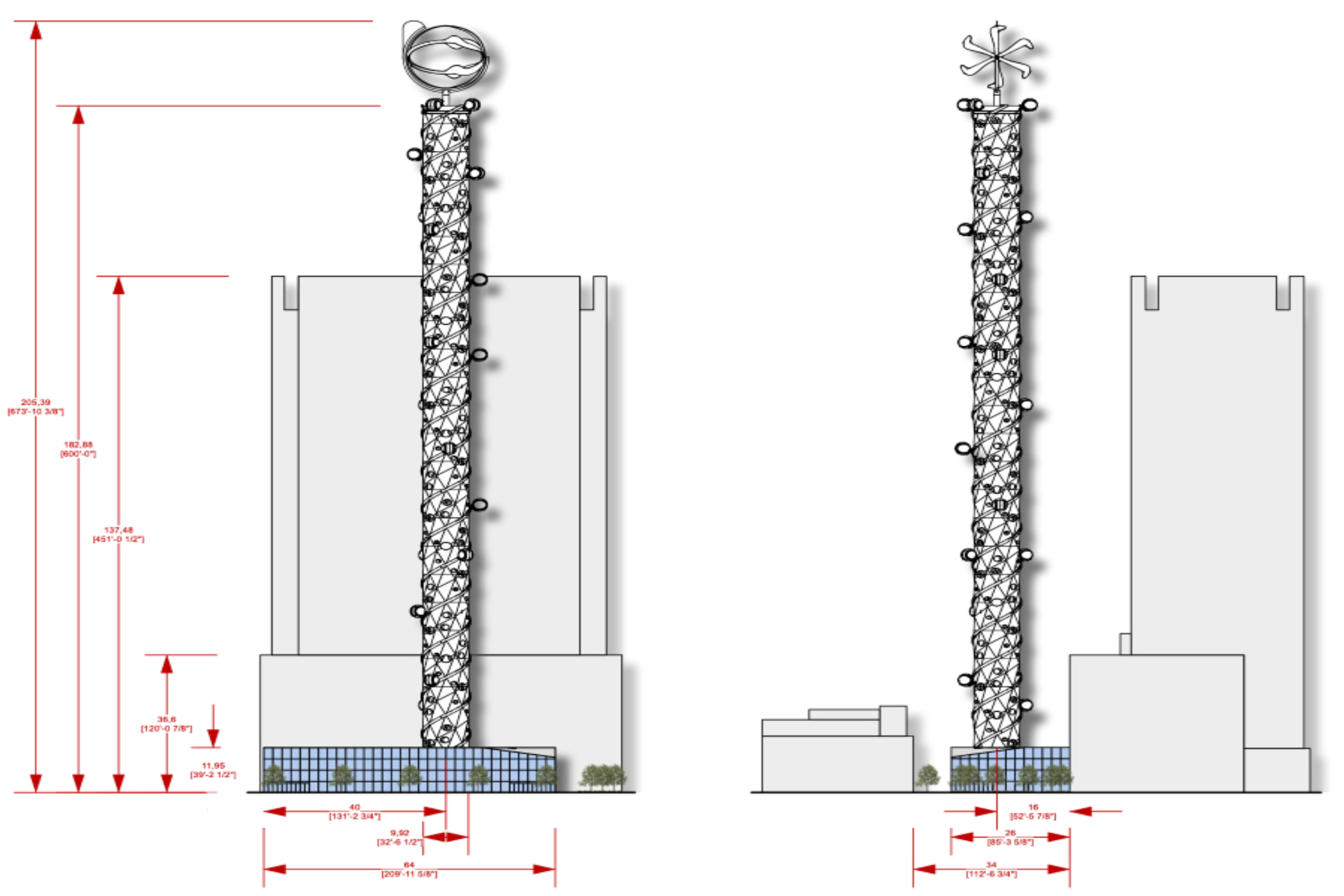It’s time to wrap up our series and coverage on McGregor Square. With almost four years of coverage and 13 posts here on DenverInfill, it has been a great journey to see this project go from a rendering to what it is today. In “Part 1” of our final update series, we explored the inside of all three buildings featured in McGregor Square and broke down all the details of the project. For today’s “Part 2”, we are exploring the exterior and ground-level of the project.
While McGregor Square has been open for some time now, we waited for the smoke and haze to clear to provide clear exterior photos. Without further ado, let’s start with a 360 around the outside project.
As a refresher, here is the breakdown of each of the three buildings. The red brick building closest to Coors Field is the Rally Hotel, providing 176 hotel rooms. The beige brick building, connected via sky-bridge to the hotel, is the condo building providing 103 for-sale homes. The brick and glass building, on the southern end, is the office building featuring 200,000 square feet of office space. Each of these buildings contributes to the 70,000 square feet of retail throughout the project.
The view of McGregor Square and Coors Field from Lower Downtown is pretty neat. Below is an additional panorama.
While the vertical development is outstanding, the star of the show is the main central plaza and Wynkoop Promenade, the walkway between 20th Street and Coors Field. During All-Star Week, particularly on the day of the All-Star Game, McGregor Square was packed to the brim with fans from around the country watching the game in this vast public space. To be able to see the finishes and open spaces, we opted to take photos the day before the All-Star Game, which still gathered quite the crowd in the early evening. Below are a bunch of photos of both the main plaza and Wynkoop Promenade.
Wrapping up, here are a few more photos of the spaces in and around the food hall.
McGregor Square is a huge win for Downtown Denver. We are thrilled to see such a great public space surrounded by mixed-use development. Congratulations to the architects, Stantec, the builders, Hensel Phelps, the Colorado Rockies, and everyone else who worked tirelessly to make this project happen.




































Pretty cool! I like the lawn concept. Curious why there weren’t any trees planted maybe at the top of the lawn for shade. Also curious why I don’t see as many pine trees planted in downtown landscapes.
I think it has to do with evergreen trees’ physiology–they don’t do well in urban environments because their needles collect pollution, and unlike deciduous trees they don’t shed their needles in the fall. Over time the pollution builds up, harming their ability to absorb oxygen. At least that’s what I remember from my environmental science class in college…
Visibility of the huge screen on the opposite side of the courtyard.
This project is strikingly well scaled to Denver, a rare improvement over the ‘build to the lot lines, higher is better’ approach that developers have forced their designers to use. In future planning and zoning I hope that MacGregor Square will come up as an example of doing it right for the development community.
I agree that the project is well scaled and well done. However, look at the zoning code and then look at the land values. “Build to the lot lines, higher is better” is done because (1) zoning in Denver is very restrictive & prescriptive, and (2) the land prices are so absurd, it would be stupid not to maximize the new development to cover every square foot of developable space that’s allowed. This development benefited from being built for and on behalf of the Coors Field stadium owners, who’ve owned this lot for decades, and purchased it when it was much, much cheaper. Furthermore, the developers worked with the city to zone this lot a special PUD (https://www.denvergov.org/media/gis/WebDocs/CPD/PUD_Docs/PUD_G_19.pdf), so that the zoning fits exactly the buildings that you got, not an inch higher or wider.
I like how the the corner of the office building goes from convex to concave on the top, makes it quite a bit more distinctive.
Yeah, this is the kind of development that makes you wonder why it wasn’t done, like, twenty years sooner. It’s just so natural and effective at what it’s trying to accomplish. I really hope businesses are able to sustain themselves when foot traffic reduces between October and April due to 35,000–50,000 people not showing up to watch baseball 81 times a year.
It’s also made me think a lot about the surrounding area and how developers could jump on this bandwagon. Like too much of downtown, it’s still ridden with parking lots. Some of them get a lot of use on game days; others are ripe for building—and right now. My vote is the devastatingly underutilized lot behind Viewhouse and the power station. This needs to be willed into an engaging, multi-level game day space.
Most of that back parcel is slated to be a festival space in the future. Sounds like it can’t be much more than that as the sale of land included vertical development restrictions.
https://www.bizjournals.com/denver/news/2020/12/21/colorado-rockies-east-plaza-coors-field-denver.html
Festival space….aka homeless tent camp.
I am sure they are in no rush to create any green space as long as
the city has not figured out the homeless situation.
Definitely feels like a fountain should be in the center of that plaza
There are fountains on the promenade! So this isn’t completely a fountain-less project. 🙂
I like it. I’ve been there 5 times now. I love that the some of the seating inside and outside is cushioned and quiet comfortable. The plaza outside is inviting to people watching and socializing, including free cornhole toss games for families with children. There is a cool wall in the Food Court lined-up with dozens of pour your own tap craft brews, but I noticed not many people are trying it…like no one. I speculate, except for the cool sports bar named Tom’s with it’s dozens of giant tv screens and blaring audio pulling in the latest game, I believe every business in the food court will be forced to shut their businesses within a year. There just doesn’t seem to be enough business to sustain their high rent and numerous employees it takes to run these operations. And once the Rockies are out of season, they will really be hurting.
We don’t do fountains here in Denver. We live on the arid plain. The grassy area looks big in pictures and renderings but it really isn’t that big at all. Trees in the grass wouldn’t make sense due to space and perhaps even sunshine could be sparse at certain times of day. Pine trees are not easy to grow here and you will see them most in suburban areas. Pine trees downtown wouldn’t make sense aesthetically and from a care perspective. And seriously, there are so many empty grates where trees should be in downtown because we don’t take care of our downtown trees the way we should be. It’s sad really.
Decorative water fountains are not heavy water users, contrary to public perceptions, as the water is recycled. But surveys show that fountains are not that popular with the public. Fountains can provide a cooling effect as well as have aesthetic value. I absolutely love the water fountain at the Englewood CityCenter.
whaaat? Fountains if done right can be very popular with people. Have you seen Buckingham fountain in Chicago? Or the International Fountain in Seattle?
IMO Denver is in need of a big sculpture fountain plaza somewhere. On the 5280 trail would be nice. (Benedict fountain is not up to par) lol
Contrary to the majority, I think this project is a train wreck. It’s kind of schizophrenic and it hurts my eyes like the low end of Las Vegas.
Turned out nice. As stated previously, it’s WAY past time that the lots directly across from the main entrance to Coors Field be developed into something appealing.